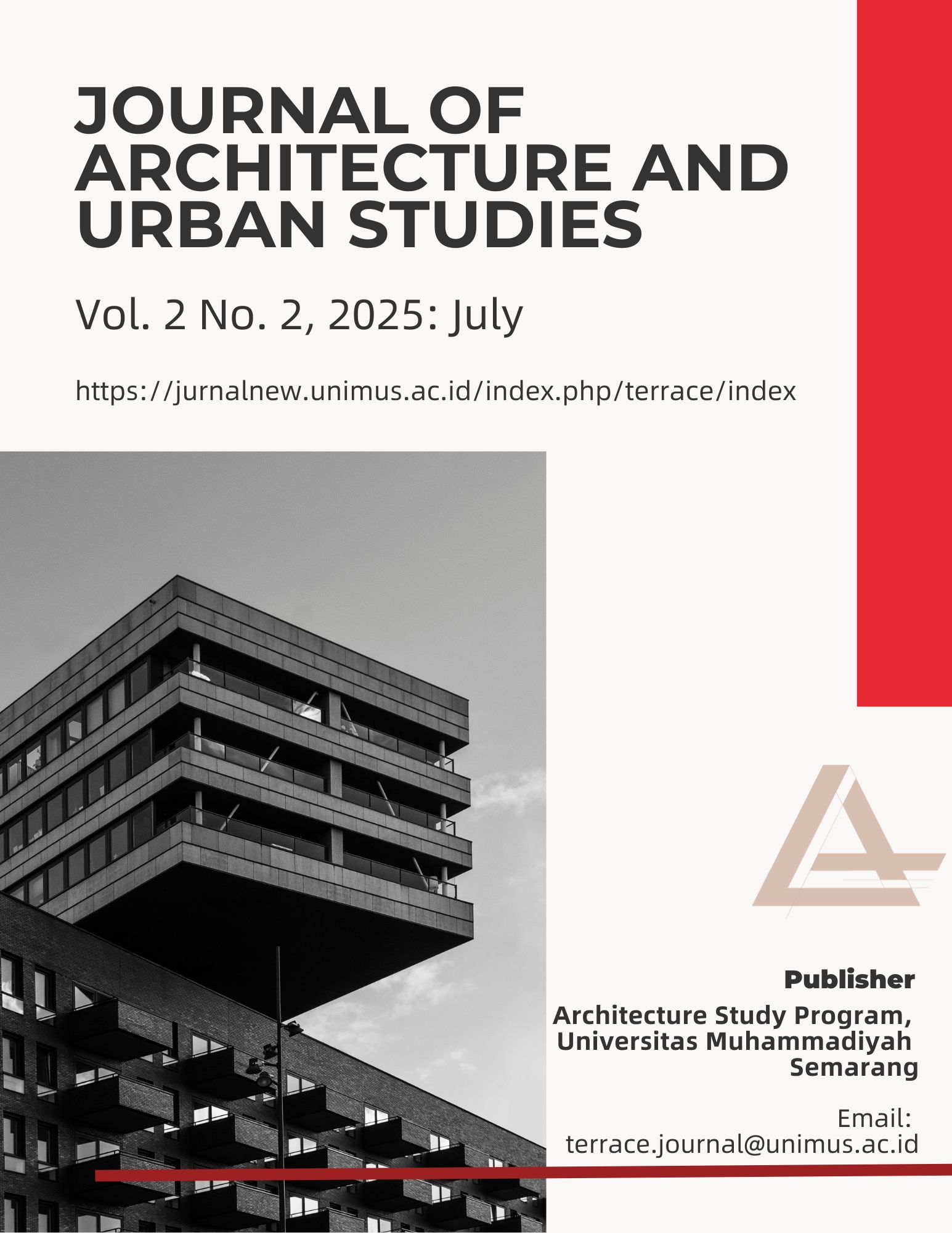Reinterpreting the Bulus in the Mihrab of Masjid Agung Demak: Cultural Symbolism, Architectural Sustainability, and Community-Based Conservation
Keywords:
bulus, Masjid Agung Demak, Islamic architecture, heritage symbolism, sustainabilityAbstract
The degradation of coastal environments and the loss of cultural identity in heritage architecture due to climate change and urban development have raised concerns about the relevance of traditional symbols in promoting sustainability. In the case of Masjid Agung Demak—Indonesia’s oldest mosque and a spiritual legacy of the Wali Songo—the presence of the bulus (softshell turtle) motif in the mihrab invites deeper reflection on its contemporary significance. This research investigates how the bulus, traditionally viewed as a symbol of balance and resilience in Javanese cosmology, can be scientifically reinterpreted as an ecological and cultural emblem within Islamic architectural heritage. The objective of this study is to explore the potential of the bulus motif to inform regenerative conservation strategies that integrate spiritual symbolism with environmental sustainability. Using a qualitative method that combines architectural semiotics, cultural anthropology, and sustainability discourse analysis, the study identifies the bulus as a nexus of spiritual, ecological, and communal meanings. Findings reveal that the motif is not merely decorative but functions as a biocultural signifier that embodies Islamic-Javanese values of patience, adaptability, and environmental stewardship. Recontextualizing the bulus within sustainability narratives enables a participatory model of heritage conservation that fosters local ecological awareness and reinforces community resilience amid ongoing environmental challenges.
References
I. Purnamasari, E. M. Simaremare, S. Y. Dhalimunte, A. Marpaung, M. Sihotang, and M. D. Nazwa, ‘Pengaruh Islam dalam Pembentukan Kerajaan-Kerajaan di Sumatera dan Pantai Utara Jawa’, Islam & Contemporary Issues, vol. 4, no. 1, Art. no. 1, Jun. 2024, doi: 10.57251/ici.v4i1.1357.
M. ZAKI, ‘KEARIFAN LOKAL JAWA PADA WUJUD BENTUK DAN RUANG ARSITEKTUR MASJID TRADISIONAL JAWA (STUDI KASUS: MASJID AGUNG DEMAK)’, masters, Undip, 2017. Accessed: Jun. 16, 2025. [Online]. Available: https://eprints.undip.ac.id/60450/
D. Ramadhana and A. Dharoko, ‘RUANG SAKRAL DAN PROFAN DALAM ARSITEKTUR MASJID AGUNG DEMAK, JAWA TENGAH’, INERSIA lnformasi dan Ekspose Hasil Riset Teknik Sipil dan Arsitektur, vol. 14, no. 1, pp. 13–25, Apr. 2018, doi: 10.21831/inersia.v14i1.19491.
Awaliyah, ‘RESOLUTION OF DEMAK COASTAL CONFLICT’. Accessed: Aug. 20, 2023. [Online]. Available: https://journal.unpad.ac.id/jkrk/article/view/35147/0
D. N. Awaliyah, ‘ISLAMIC ARCHITECTURE: SHAPING CULTURAL IDENTITY, FOSTERING COMMUNITY COHESION, AND PROMOTING INCLUSIVITY’, Journal of Islamic Art and Architecture (JIAA), Accessed: Jun. 16, 2025. [Online]. Available: https://journal.walisongo.ac.id/index.php/JIAA/article/view/18900
D. N. Awaliyah, ‘The Symbols of Inculturation and Interfaith in The Demak’s Great Mosque’, Sunan Kalijaga: International Journal of Islamic Civilization, vol. 7, no. 1, Art. no. 1, Sep. 2024, doi: 10.14421/skijic.v7i1.2791.
I. D. Jayanti, ‘PERAN RADEN PATAH DALAM MENYEBARKAN AGAMA ISLAM DI DEMAK PADA TAHUN 1478-1518’, Krinok: Jurnal Pendidikan Sejarah dan Sejarah, vol. 1, no. 3, Art. no. 3, Dec. 2022, doi: 10.22437/krinok.v1i3.18132.
A. Andeng and R. Darmiwati, ‘PENDEKATAN PENGARUH KONSEP ARSITEKTUR ISLAM MASJID AGUNG DEMAK PADA PERANCANGAN MASJID DI JAWA’, The Center for Sustainable Development Studies Journal (Jurnal CSDS), vol. 1, no. 2, Art. no. 2, Dec. 2022, doi: 10.37477/csds.v1i2.403.
D. N. Awaliyah, ‘The Identity of Demak: Unveiling Culture, Architecture, Heritage and Historical Significance’, International Journal of Architecture and Urbanism, vol. 7, no. 3, Art. no. 3, Dec. 2023, doi: 10.32734/ijau.v7i3.13801.
M. Pataruka, ‘'NGALAB BERKAH’ PADA RUANG RITUAL TRADISI DAN RELIGI MASJID AGUNG DEMAK’, Jurnal Arsitektur ZONASI, vol. 1, no. 2, Art. no. 2, Oct. 2018, doi: 10.17509/jaz.v1i2.12394.
L. A. Ningtiyas and L. Ayundasari, ‘SUNAN GESENG: THE CATALYST OF ISLAMIC RENAISSANCE IN 15TH CENTURY KEDIRI’, Al-Tsaqafa : Jurnal Ilmiah Peradaban Islam, vol. 20, no. 2, Art. no. 2, Dec. 2023, doi: 10.15575/al-tsaqafa.v20i2.27802.
S. W. Auvaria, ‘IMPROVEMENT OF AWARENESS AND ASPECT OF COMMUNITY PARTICIPATION IN ENVIRONMENTAL MANAGEMENT AND CLIMATE CHANGE ADAPTATION BY ECO-MOSQUE’, Al-Ard: Jurnal Teknik Lingkungan, vol. 4, no. 1, Art. no. 1, Sep. 2018, doi: 10.29080/alard.v4i1.321.
N. H. N. Nisa, ‘Mengenal Warisan Sejarah Peninggalan Islam Masjid Agung Demak di Nusantara’, Manaqib: Jurnal Sejarah Peradaban Islam dan Humaniora, vol. 2, no. 2, pp. 182–194, Dec. 2023, doi: 10.24239/manaqib.v2i2.2576.
E. qurnia Hayati and Alimni, ‘Islamisasi Ajaran Islam di Nusantara’, AL-MANAR : Jurnal Komunikasi dan Pendidikan Islam, vol. 12, no. 1, pp. 69–78, May 2023, doi: 10.36668/jal.v12i1.417.
R. Foltz, ‘Fazlun M. Khalid, Signs on the Earth: Islam, Modernity and the Climate Crisis’, Journal for the Study of Religion, Nature and Culture, vol. 14, no. 4, pp. 518–519, 2020, doi: 10.1558/jsrnc.38219.
Downloads
Published
How to Cite
Issue
Section
License
Copyright (c) 2025 Journal of Architecture and Urban Studies

This work is licensed under a Creative Commons Attribution-NonCommercial 4.0 International License.












